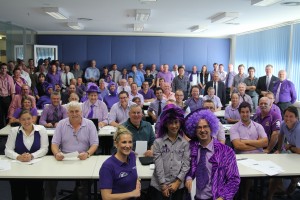Heightening epilepsy awareness today – Purple Day (March 26, 2014)
Today we are teaming with the Epilepsy Foundation to release new research coinciding with Purple Day – a global, awareness raising initiative for epilepsy. Already today, the Epilepsy Foundation has raised $100,000 for this worthy cause, and is still counting!
New research released by the Epilepsy Foundation today reveals almost one-in-two Australian adults living with the country’s most common, chronic brain disorder are three-times more likely to experience abnormally high levels of anxiety compared to the general population.
Leading doctors, everyday heroes and The Amazing Race winner, Celebrity Apprentice runner-up and model, Nathan Jolliffe, 28, affected by the stigmatised neurological disorder, are joining forces today to highlight the role of anxiety and depression encountered by Australian adults living with epilepsy and the importance of spreading the word by donning purple.
 According to new research author, Dr Chris Peterson from the Epilepsy Foundation, Melbourne, the new research highlights the significant threat posed by the stigma of epilepsy on a person’s mental health and wellbeing.
According to new research author, Dr Chris Peterson from the Epilepsy Foundation, Melbourne, the new research highlights the significant threat posed by the stigma of epilepsy on a person’s mental health and wellbeing.
“Our research shows the higher the level of exposure to the stigma surrounding epilepsy, the greater the increase in levels of anxiety and depression among those living with the disease.
“Factors that influence anxiety and depression levels in people with epilepsy include employment status, level of education, control of epilepsy, number of epilepsy medications and most importantly, stigma,” Dr Peterson said.
Professor Mark Cook, President of the Epilepsy Foundation and Director of Neurosciences at St Vincent’s Hospital, Melbourne, says the social consequences of the stigma faced by people with epilepsy are often worse than the disorder itself.
“We haven’t seen attitudes change over centuries.”
Nathan Jolliffe, 28, Sydney, who had epilepsy as a child, acknowledges he was too embarrassed to reveal his condition to friends and didn’t want to deal with his epilepsy.
“As a kid, you don’t want to feel different to anyone else. So I didn’t tell anyone about what I was going through.
“It can be intimidating to witness a seizure. Some people don’t know what to do in the event of a seizure, and that can be very confronting,” Nathan said.
Nathan says having his parents around during a seizure helped him immensely and stresses the importance of having support from those around you.
“Seizures and epilepsy would be better perceived by the general public if we encouraged greater understanding and education.
“By relying on my great family support network and choosing to learn more about epilepsy, I’ve overcome some of the anxiety associated with the condition,” Nathan said.
So for Purple Day, why not don your best purple garment and show your support for people living with epilepsy and their families. And don’t forget to drop a dollar or two into the tin to support the cause, because every cent counts.
Named after the internationally recognised colour for epilepsy (lavender), March 26 is Purple Day – a day dedicated to spreading the word about epilepsy.
To learn more about Purple Day or epilepsy, contact the Epilepsy Foundation on 1300 852 853 or visit www.epinet.org.au.
